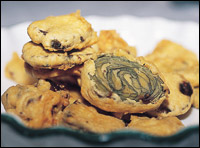


 Garam Garam Bhajiya!
Garam Garam Bhajiya!On a cold, wet monsoon afternoon when you are holed up indoors, you cannot do better than give yourself a gourmet treat with a plateful of hot, tasty bhajiyas. Most housewives take the easy way out by frying onions and potatoes in a chana dal batter. But restaurateur KAMLESH BAROT shows that you can make as many bhajiyas as there are ingredients in the Indian kitchen. |
|
GIVE me a plateful of steaming hot, assorted bhajiyas and a mug of tea on a rainy day, and I can forget the world and be content to stay indoors as long the gourmet snack lasts! Of course, bhajiyas are gourmet snacks, or gourmet savouries, and let no one tell you otherwise. The fact that we make them so infrequently at home itself makes the bhajiya a sort of exclusive delicacy to be looked forward to. The bhajiya traces its origins to Gujarat, the south of Gujarat, actually, where the land is fertile and the produce of the land comprises all kinds of green, leafy vegetables and fat, juicy tomatoes. The enterprising Gujaratis, though vegetarian in outlook, are hearty eaters; they put these veggies to use even after the local mainstream cuisines had finished with them. They began using them as stuffings for bhajiyas. I�m told the bhajiya first became popular with travellers from Gujarat in days when journeys were made on foot. Travellers carried what is known as a bhattu, that is a long stick on which, in a small knapsack, a tiffin box was tied. In the bhattu would be bajri rotlas that were dry and could remain edible for days on end, and in these rotlas, were the bhajiyas. Since journeys were long and meals along the way were difficult to get, travellers batter-fried all perishable foods so that they didn�t get stale. They were deep fat-fried and the consequent food product, the bhajiya, came to contain lot of calories, plus carbohydrate and fat content. The bajri rotlas and the bhajiya with crushed onion made a very satisfying meal. That�s how the humble bhajiya came to be the traveller�s staple diet on his journeys. I think the exact definition of bhajiya is a batter-fried bhaji. At least, that is the closest the translation can come to. The Gujaratis make their bhajiyas batter-fried; the South, which picked up the tradition, ignored the fillings and took to making bhajiyas only with the batter! These are called bondas. In Gujarati bhajiyas, the batter is used with a dual purpose: it coats the filling and acts as a cover; and, it acts as a binding agent to hold the filling together when the bhajiya is being fried. Bhajiya batters are made mainly of besan, that is chana dal or chickpea flour, and very often they are seasoned according to the filling of the bhajiya. Like if the filling is chilli, then the batter is seasoned with salt and lime to contain the heat of the chilli. And if the filling is tomato, then the batter is seasoned with ajwain to bring out the sharpness of the tomato in the bhajiya. The art of frying a good bhajiya lies in the consistency of the batter. A thick batter holds the bhajiya in shape whereas a batter of thin, pouring consistency produces a crispier bhajiya. The temperature of the oil used for frying the bhajiya plays a big role, too. It should not be so hot that it burns the bhajiya, nor too lukewarm so that the bhajiya requires extra frying and turns out limp! Finally, the filling. Gujaratis use all kinds of root vegetables for bhajiyas. Like the onion and potato, certainly, which can be deep-fried and kept for long in oil so as to get that brown look. Or they use fruit vegetables like banana and tomato. But of late, fillings are used in bhajiyas like alcohols are used in cocktails. Anything goes! Though some leafier veggies, like the cabbage, and even the cauliflower, which have great water content, are not suited for bhajiyas. The action of the oil deprives the bhajiya of its shape and taste. If vegetables are not readily available, sandwich bhajiya can be made with bread. Now that�s what I call modernisation!
|

Home Page